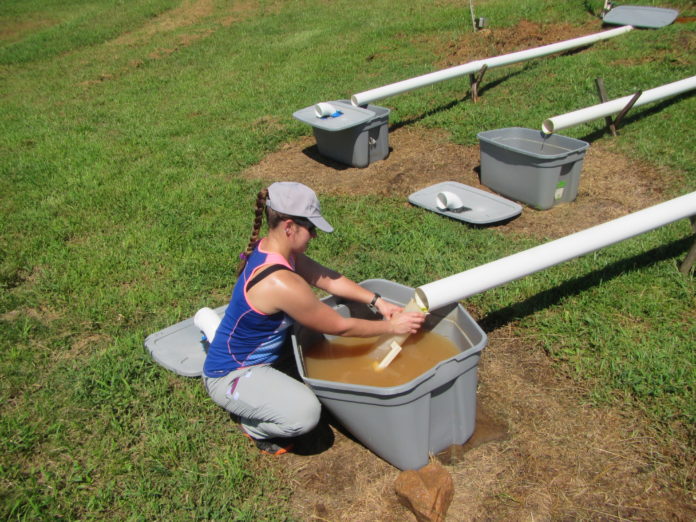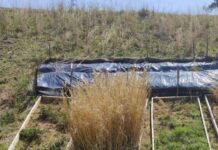By Christina N. Kranz, Ph.D.; Joshua L. Heitman, Ph.D.; Richard A. McLaughlin, Ph.D.
Background
Soil disturbed by mass grading associated with roadway construction exhibits increased bulk density, reduced infiltration rates and reduced water storage capacity. The compacted soils have similar runoff coefficients to impervious surfaces, thereby yielding increased surface runoff. Mass grading generally results in subsoil exposed at the surface. Subsoils are low in nutrients and organic matter and generally limit substantial vegetation establishment, which leads to long-term erosion and sediment control problems. Many sources recommend tilling compost into the soil to improve soil conditions on disturbed, degraded soils. However, there has been little research aimed at determining the optimal compost application rates to concurrently improve stormwater infiltration or storage, increase vegetation establishment and limit offsite export of dissolved pollutants. Compost incorporation has the potential to achieve all of these goals.
Research Objective
• This field experiment was designed to determine compost incorporation rates optimized for:
• Increased infiltration or water storage.
• Effective vegetation establishment.
• Improved water quality from stormwater runoff.
Field Plot Setup and Methodology
Field plots were established at the Sediment and Erosion Control Research and Education Facility in Raleigh, North Carolina. To simulate a construction site, topsoil and vegetation were removed to expose the subsoil, and the subsoil was graded to achieve a uniform surface with a 5% slope.
Two sources of yard waste compost were tested: a commercial product and campus compost (produced on North Carolina State University’s campus). The commercial compost was Seal of Testing Assured certified by the US Composting Council. All compost was incorporated to a depth of 15 cm (6 inches). The commercial compost was incorporated at 10%, 30% and 50% compost by volume. The campus compost was incorporated at 30% compost by volume. There was also a tilled-only control (no compost). All treatments received lime, fertilizer and seed according to North Carolina Department of Transportation guidelines.1
After each rain event, runoff volume was measured for each plot, and subsamples of the runoff were analyzed for water quality (turbidity, total suspend solids and dissolved pollutants). Vegetation biomass samples were taken four times over the course of a growing season. One year after plot establishment, soil bulk density and infiltration rate (single-ring infiltrometer) measurements were taken from treatment plots. Bulk density measurements also allowed us to calculate the moisture content of each treatment. One of the benefits of compost is it can increase the moisture holding capacity of soils.
Both the compost source and compost rate were evaluated using an analysis of variance for statistical difference between treatments. Comparisons were made between runoff volume, water quality, infiltration rate, bulk density, moisture content and vegetation biomass. This analysis identified how effectively a particular treatment performed over a wide range of treatment combinations.
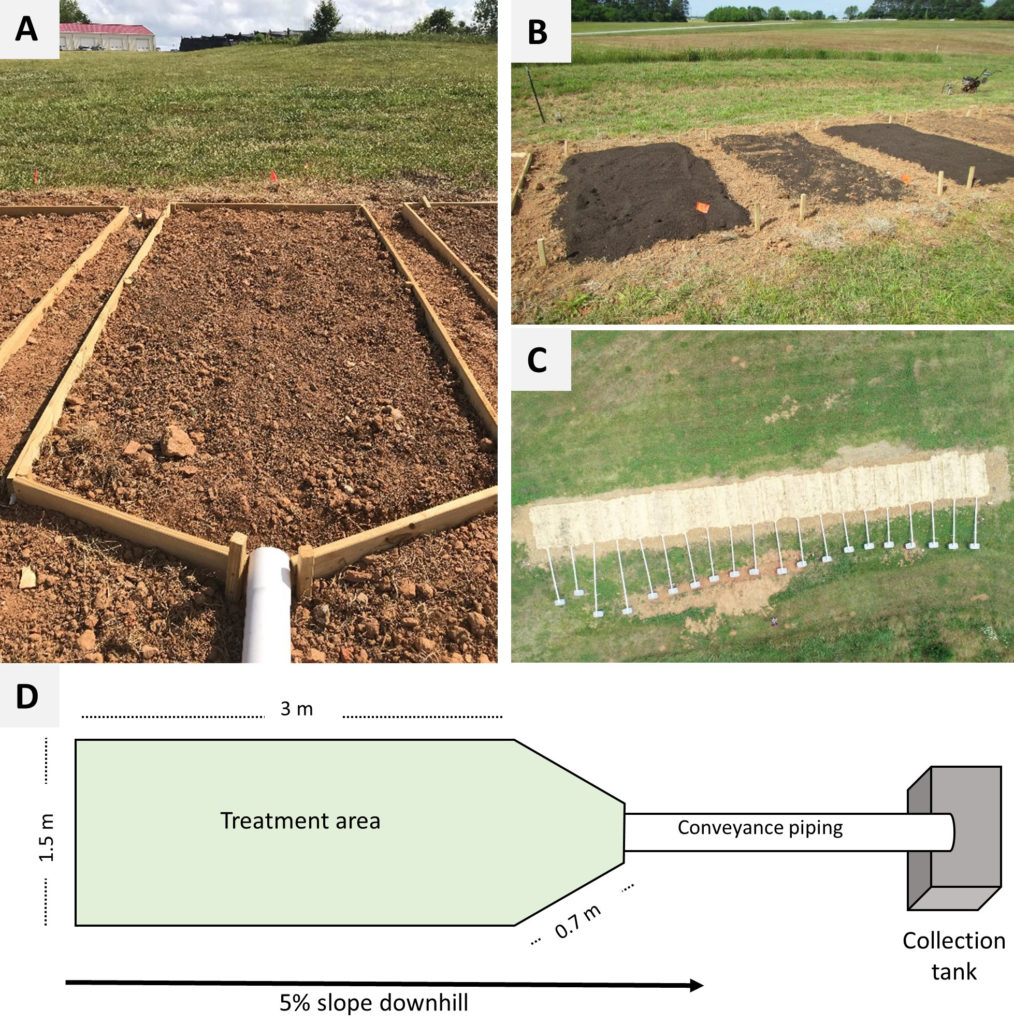
Findings: Runoff
There were no differences for runoff volume collected between treatments for each individual rain event. In all cases, runoff volume was less than 10% of the total rainfall. The soil texture at this site was a sandy clay with 52% sand. Tilling alone was enough to loosen the soil in order to achieve high infiltration rates for this sandy soil. Two previous field studies at this location included a compacted control and a tilled control in addition to a compost-amended treatment (5 cm depth).2,3 In both studies, infiltration with compost incorporation was significantly increased compared to the compacted control but not compared to the tilled control. This was similar to the pattern we observed in our experiment, with no difference between tillage and tillage with compost—up to 50% compost by volume.
Findings: Water Quality
There were no differences in turbidity, total suspended solids or dissolved pollutants (NO3-, NH4+, PO43-, Cu, Pb, Zn) between treatments. The use of compost, up to 50% by volume, did not increase nor decrease the runoff water quality compared to a no compost control.
Findings: Vegetation Biomass
After one growing season, the total vegetation biomass from each treatment was calculated from four individual mowing events. The 50% commercial compost had the largest amount of vegetative biomass followed by the 30% commercial compost and the 10% commercial compost. The 30% campus compost and the no compost control produced the least amount of vegetative biomass and were statistically the same (i.e., there was no change in biomass production from the 30% campus compost compared to the control).
The commercial compost produced more vegetative biomass compared to the campus compost and the no compost control. Biomass tended to increase with increasing amounts of the commercial compost. A nutrient analysis conducted on the two sources of compost show the campus compost had higher levels of organic matter (80%) compared to the commercial compost (27%). The high levels of organic matter in the campus compost tell us the compost was not fully mature at the time of application. As a result, the campus compost likely reduced nutrient availability rather than increasing it.
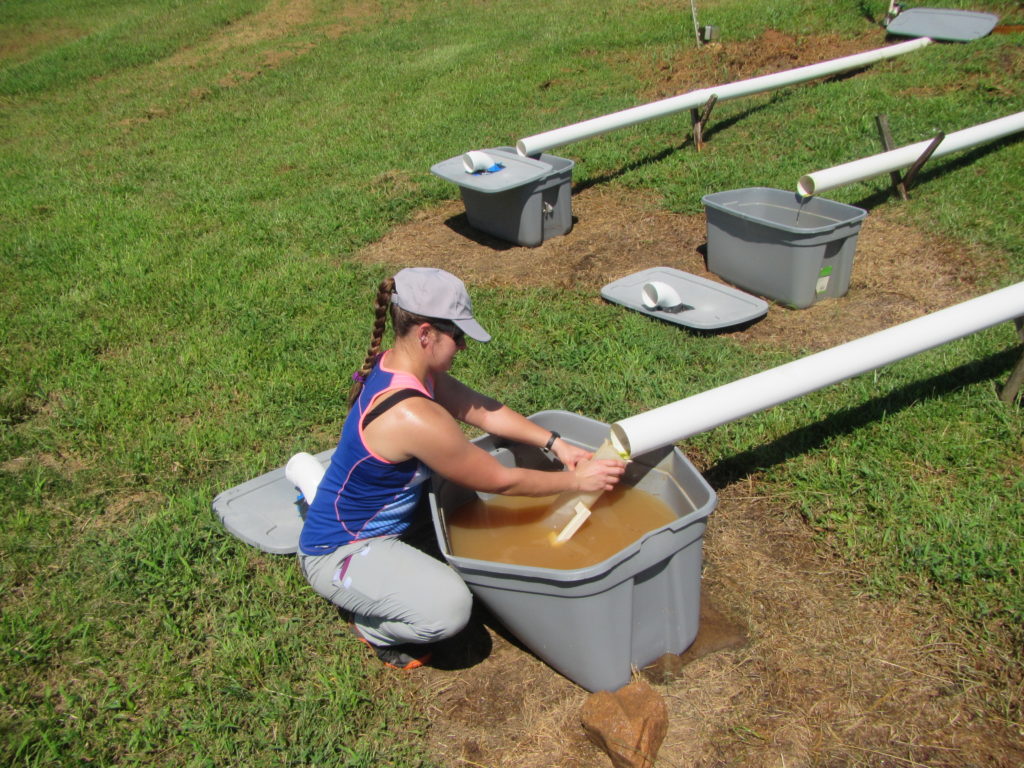
Findings: Moisture Content, Bulk Density and Infiltration Rate
All compost-amended treatments had significantly increased moisture content compared to the no compost control. However, there were no differences in the moisture content between all compost-amended treatments. The 50% commercial compost had the lowest bulk density (0.9 g cm-3) followed by the 30% commercial compost (1.0 g cm-3), 30% campus compost (1.0 g cm-3), 10% commercial compost (1.2 g cm-3), and the no compost control (1.3 g cm-3). With each increase in compost application rate, there was a significant decrease in the bulk density, which in turn affected infiltration rates.
Compost incorporation significantly improved the infiltration rate to 36 to 68 cm hr-1 (14 to 27 in hr-1) compared to the no compost control at 27 cm hr-1 (11 in hr-1). As the compost application rate increased for the commercial compost, the resulting infiltration rate increased. The infiltration rate for the 50% commercial compost and the 30% campus compost were the fastest and statistically the same. The campus compost texture resembled more of a mulch like texture with larger pieces of woody debris, while the commercial compost was screened to a finer texture resembling peat. Bigger particles in soil could create larger channels for stormwater to infiltrate, which could be one of the reasons it took only 30% from the campus compost to have the same infiltration rate as 50% from the commercial compost. Note that all of the infiltration rates are at least 10 times that of typical soils, suggesting that areas with these treatments could absorb a great deal of rain and runoff from impervious areas.
While we found no differences between treatments for the runoff volume captured per rain event, we did find differences between treatments for infiltration rate (measured once one year after plot establishment). Average rainfall and storm intensity over the course of this experiment were 3.5 cm and 5.5 cm hr-1 (1.4 in and 2.2 in hr-1), respectively. The measured infiltration values are more than four times the amount of rain the field site received. The rainfall and storm intensities were too small to capture differences between treatments for runoff volume, but infiltration measurements suggest compost incorporation increases the ability of soil to absorb rainfall and possible runoff.
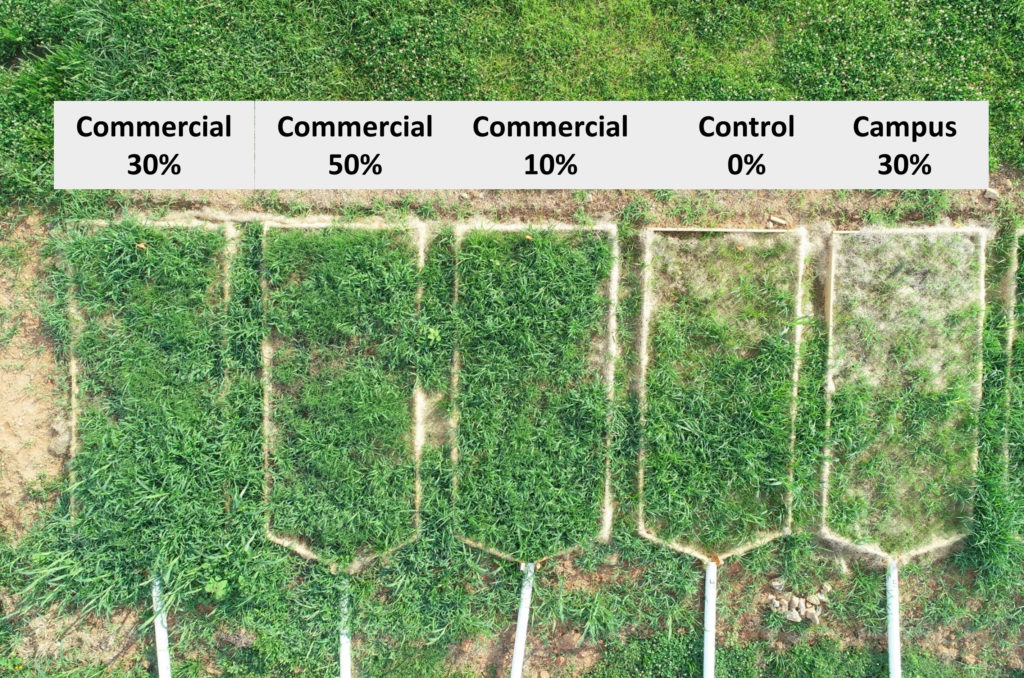
Conclusions
Currently, there is a lack of research data available to support decisions on the optimal rate of compost incorporation for stormwater infiltration, water quality and vegetation establishment. Consulting companies and government agencies often recommend compost rates with little specific evidence to support them. This research effort sought to experimentally determine an optimal compost-amendment range for post-construction soils based on runoff volume reduction, infiltration rate, water quality parameters and vegetation establishment.
The experiment demonstrated that tilling may be sufficient to reduce runoff volumes, but that commercial compost did enhance vegetation biomass production. Soils are required to be vegetated prior to the end of construction, and compost incorporation prior to seeding has the potential to reduce the effects of compaction by decreasing the bulk density and increasing the infiltration rate, plus increasing vegetation establishment. Having good vegetation coverage is necessary for long-term erosion and sediment control. Our results suggest that a onetime incorporation of high quality compost at 10% or higher may improve soil for highway stormwater management but that increasing compost rates above 30% did not necessarily enhance benefits.
Compost should be STA certified or meet U.S. Composting Council guidelines for certification. This ensures that the compost meets certain characteristics, such as C/N ratio, which results in the most benefits from using compost. If a certified compost is not available, then a certified laboratory can test the compost that is available to you. For more information on STA compost requirements, finding a STA certified compost near you, or finding a certified laboratory to test compost, please visit the US Composting Council’s website at www.compostingcouncil.org.
Acknowledgements
The North Carolina Department of Transportation sponsored the research presented in this article. The findings expressed in this article are those of the authors and do not necessarily reflect the view of the sponsors.
References
1) NCDOT, 2015. Erosion and sediment control guidelines. NCDOT, 453. Available from: https://connect.ncdot.gov/resources/hydro/HSPDocuments/NCDOT_ESC_Manual_2015_.pdf (accessed 06 July 2021).
2) Mohammadshirazi, F., Brown, V.K., Heitman, J.L., McLaughlin, R.A., 2016. Effects of tillage and compost amendment on infiltration in compacted soils. Journal of Soil Water Conservation 71 (6), 443–449.
3) Mohammadshirazi, F., McLaughlin, R.A., Heitman, J.L., Brown, V.K., 2017. A multi-year study of tillage and amendment effects on compacted soils. Journal of Environmental Management 203, 533–541.
About the Experts
Christina N. Kranz, Ph.D., is a postdoctoral scholar in the Crop and Soil Sciences Department at North Carolina State University. Her research focuses on using soil amendments to improve stormwater infiltration and reduce erosion.
Joshua L. Heitman, Ph.D., is a professor of soil physics and hydrology at North Carolina State University.
Richard A. McLaughlin, Ph.D., is a professor and an extension specialist in sediment and erosion control in the Crop and Soil Sciences Department at North Carolina State University.



